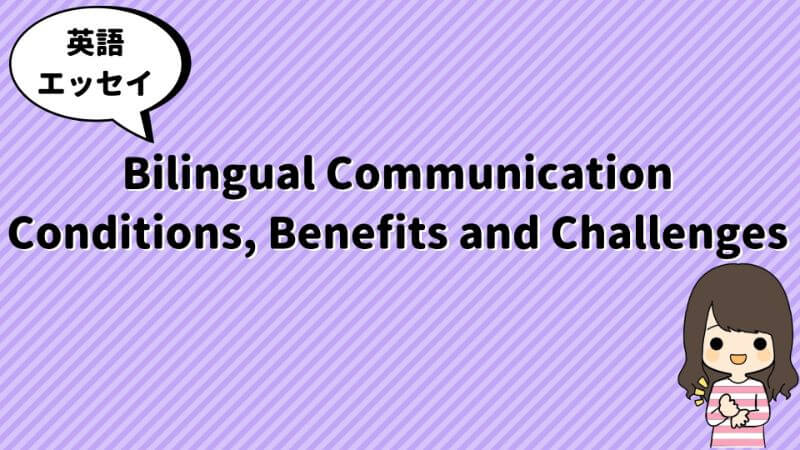 Multilingirl わた
Multilingirl わた
I know it’s a bit weird to write in English, but anyways, I want to share with you this research paper I wrote when I was in university, though it may be too “academic” for this Website. I hope you enjoy it!
 【村上春樹】作品を外国語で《多読》する勉強法がオススメな理由
【村上春樹】作品を外国語で《多読》する勉強法がオススメな理由
Introduction
Have you ever wondered how a bilingual brain works? It is hard to imagine for those who are not bilinguals how it feels to fluently speak two or more languages alternately without hesitation. Even though the mechanism of bilingual brain remains a mystery for many people, they indeed dream to be bilinguals, or to grow their children as bilinguals.
As schools, companies and society claim for globalization, the ability to command multiple languages is more and more demanded, and Bilingualism is getting a closer issue for many people. Bilingual education in elementary schools is spreading quickly and it has become commonplace in many countries all over the world, especially in multi-ethnic nations, which are facing a rapid increase in immigrants and foreign workers.
Casey Schwartz reports that bilingual education is a growing trend across the United States, with hundreds of elementary schools offering total immersion studies in Spanish, Mandarin, and French (2001). According to the U.S. Census Bureau, about 21 percent of Americans speak “well” or “very well” a language other than English at home, thus, one in five Americans (Perry, 2008).
Despite the attention and expectations drawn to Bilingualism, its challenges are often neglected. For example, Semilingualism is one of the attendant risks one can be at in a multilingual environment, although this term has brought into disrepute, because of its deficit connotation and inappropriateness in terms of linguistics (Ministry of Education, New Zealand, 2006). It might be more suitable and proper to refer to these people as bilinguals to some extent. The definition of Bilingualism and its degree will be discussed later in this paper.
The complete acquisition of two or more languages in one’s childhood undergoes complex difficulties, and bilinguals do not always face merely benefits, but also challenges. This paper first examines the processes in becoming a bilingual, then explores the benefits bilinguals have, and finally discusses the possible challenges bilinguals have to meet.
Processes in Becoming a Bilingual
As research regarding Bilingualism developed, the conditions and processes of language acquisition have become clearer, going beyond conventional external observations. Bilinguals command two or more languages alternately in their daily life, many of them without any difficulties.
How to Define Bilingualism
According to the Oxford Advanced Learner’s Dictionary, the word “bilingual” is defined as “able to speak two languages equally well” (2010). However, people tend to use the term when referring to someone who speaks two or more languages, in other words, as multilingual or plurilingual.
Not just the number of tongues, but also the degree of a bilingual’s language competence varies, and bilinguals can be classified into four clinal groups, based on their language ability, ranging from Passive Bilingual, Dominant Bilingual, Balanced Bilingual, and Equilingual (Klein, 2004).
Bernd Klein explains each group as follows: A Passive Bilingual is a person who is a native speaker in one, and also understands another language but cannot speak it (2004). If someone is a Dominant Bilingual, he or she is more proficient in one of the two languages, in most cases native-like (Klein, 2004). A Balanced Bilingual is more or less equally proficient in both languages, but will not necessarily pass as a native speaker in either language (Klein, 2004). If somebody passes in any situation in both languages for a native speaker, then he or she is an Equilingual, indistinguishable from a native speaker, which is what comes to mind for many people when talking about Bilinguals (Klein, 2004). In fact, this is the strictest kind of defining bilingualism.
Moreover, according to Bernd Klein, another way to classify Bilinguals is by their stage of language skills, i.e. listening, speaking, reading, and writing (2004). Listening comprehension is the minimal competence a person regarded as bilingual has in at least two languages (Klein, 2004). A passive bilingual is one who can only manage this skill in the second language, while he or she copes with it with ease, including the other three skills in his or her first language (Klein, 2004). Speaking is the ability which most dominant and balanced bilinguals, as well as equilinguals, have. Reading comprehension is the threshold, and many dominant bilinguals lack competence in this skill for their second language (Klein, 2004). Writing skills can be expected from balanced bilinguals and equilinguals, which show its difficultness compared to other language skills (Klein, 2004).
How One Becomes Bilingual
Whether bilinguals want it or not, many of them grow in multilingual environments. The conditions and circumstances in which bilinguals grow vary considerably from person to person; therefore, the process to acquire multiple language skills also varies from person to person. By acquiring two languages simultaneously in their childhood, or by learning a second language sometime after their first language acquisition, people may become bilingual (Linguistic Society of America, 2012).
According to the Linguistic Society of America, bilinguals in the U.S. are, in many cases, the children of immigrants who have their parents as native speakers of a language besides English (2012). They grow up listening to and speaking their parents’ tongue at home, and at the same time attending school, where English is the dominant language.
Children from international marriage parents or children with parents who each have different language backgrounds are likely to become bilingual as well. Not just their parents, but also other significant people like a grandparent or a caretaker consistently speaking a different language have great influence on the children, which leads them to the acquisition of a sequent language (Linguistic Society of America, 2012).
A young child needs to be exposed regularly in both languages, but just growing up in a two-language environment in an early age does not necessarily result in becoming a bilingual. The exposure to both languages needs to involve interaction (Linguistic Society of America, 2012). This means that a child exposed to a language only through television or other audio-visual media will not be able to acquire it, but a child who is spoken the language regularly by somebody will.
Many people believe that there is a critical period for learning a new language to the extent to become native-like, but this idea is not necessarily accurate. According to Lisa Chipongian, “there is certainly no specific age at which the window of opportunity closes completely” (2000). This is true in terms of grammar and vocabulary learning, what even a monoglot practices in his or her speaking language. Nevertheless, the acquisition of phonological aspects of another language gets difficult, particularly when no similar pronunciation is found in one’s first language (Chipongian, 2000). In fact, about five percent of adult bilinguals have mastered a second language in their adulthood, long after their “critical point” (Singleton, 1995). This percentage is by no means high, but as Chipongian says, “the grammar-learning window never completely closes” (2000). Thus, everyone has the potential to become bilingual, regardless of age.
Benefits to Be a Bilingual
As is commonly known, being bilingual has innumerous benefits in the course of one’s education. Casey Schwartz claims that the essential abilities “to focus in the face of distraction, to decide between competing alternatives, and to disregard irrelevant information” are boosted in bilingual children (2001). Experts group these skills together, and call them “executive functions,” which are already apparent in children as young as three or four (Schwartz, 2001). These advantages result in multiplier effects throughout a bilingual’s life.
Easier Acquisition of Other Languages
Better cognitive functions are observed in bilingual children when they switch the language by understanding what is going on around them. These cognitive skills have a great influence on the brain’s executive control system, which plays an important role in cerebral activities like high-level thought, multitasking, and sustained attention (Miller, 2015).
Once a child becomes bilingual, he or she acquires a new sequent language with ease, applying the linguistic skills they have already obtained through their two-language environment. Torry Miller states that the beneficial skills they have are the ability to easily learn new words, to spot the rhymes and connections between words and phrases, to categorize words, and to communicate smoothly and efficiently (2015).
Delay of Cognitive Damage
As aging societies increase in many countries in the world, people have a sense of crisis about senile dementia, but studies show that bilingualism can confront these frightening diseases.
Scientific research show that adult bilinguals have denser gray matter, or “brain tissue packed with information-processing nerve cells and fivers,” particularly in the brain’s left hemisphere, which is in charge of language and communication control (Perry, 2008). This result was most evident in people who became bilinguals before the age of five, which suggests that being bilingual in an earlier age has a great influence in the brain’s structure (Perry, 2008).
Moreover, Schweizer reports that when probable patients of Alzheimer’s Disease (AD) – one of the typical diseases in dementia – were examined with computed tomography (CT) scans, those who were monolinguals had significant amount of atrophies in their brains, whereas people who were bilinguals, the atrophy was not as big as the monolingual ones (2012). This means that bilingual’s brain underwent less brain degeneration, proving that Bilingualism can delay the onset of symptoms in people suffering from dementia.
Challenges a Bilingual Has
When talking about Bilingualism, people tend to point out just the benefits and advantages, but in fact, there are some disadvantages to keep in mind, though most of these detriments were denied in the past century.
Semilingualism and Other Disadvantages Claimed in the Past
At the beginning of the 20th century, bilingualism was considered “harmful to one’s development and IQ” (Myler, 2001). This was based on the idea that since the brain of a bilingual has to process twice the information compared to that of a monolingual, it would be inevitable for them to have weaker verbal skills, including the lack of vocabulary in any semantic category. Others claimed that bilinguals suffer more from ‘tip of the tongue’ moments than monolingual speakers (Myler, 2001).
Above all, Semilingualism was considered a serious problem and risk a child being in a two-language environment could have. According to Hugo Baetens Beardsmore, a Belgic linguist, Semiligual refers to those whose ability shows signs of considerable retardation in both languages (1986). A semilingual has little competence in either language, which means that he or she is not able to sufficiently command even a single language, but has partial abilities in two or more languages (Ministry of Education, New Zealand, 2006).
However, experts from New Zealand Ministry of Education claim that the proficiency in languages should not be rashly compared between bilinguals because they use their languages for different purposes and events, and its context may vary (2006). Moreover, the language ability of children living in a two-language environment is not fixed yet, having great potential to perfectly acquire both languages in the future.
Feel of Alienation from Society
Many bilinguals suffer from a sense of not belonging to the society, which is considered a more serious issue, rather than the uncertain negative effects to their intellectual aspects. In many cases, bilingual children grow in an environment where they belong to different ethnic roots, or have distinct cultural customs (Linguistic Society of America, 2012).
Bilingual children often suffer from being teased by their peers when speaking their other tongue, which has harmful effects on their self-worth (Then de Lammerskötter, 2015). It gets even more difficult for them to establish their cultural identity when the environment is not tolerant of diversity. The feel of alienation from the society can result in psychological stress and oppression, even though the advantages are worth the expected problems.
Conclusion
Despite the strongly claimed benefits and advantages of being bilingual, bilinguals experience difficult challenges. Thanks to the studies practiced in the past century, the taxonomy of Bilingualism has developed, and the process of becoming bilingual has become clear. Being a bilingual has countless advantages throughout one’s life, but on the other hand, there are certainly some disadvantages that cannot be disregarded. As Frank Smith, a contemporary psycholinguist, says, “One language sets you in a corridor for life. Two languages open every door along the way,” being able to command an extra language gives you unlimited potential in your life (qtd. in Harvard University, Arts & Humanities Division, 2015). All the obstacles that stand in your way are worthwhile overcoming.
![]()
References
Beardsmore, Hugo Baetens. (1986) Bilingualism: Basic Principles 2nd edition. Retrieved December 9, 2015, from https://books.google.co.jp/books?id=DX1JcMNgz7AC&printsec=frontcover&hl=ja#v=onepage&q&f=false
“Bilingual” (2010) Def.1. Oxford Advanced Learner’s Dictionary. 8th edition. Oxford University Press.
Chipongian, Lisa. (2000) Is There a Critical Period for Learning a Foreign Language? Brain Connection. Retrieved December 5, 2015, from http://brainconnection.brainhq.com/2000/06/27/is-there-a-critical-period-for-learning-a-foreign-language/
Harvard University, Arts & Humanities Division. (2015) Why Study a Foreign Language. Retrieved December 25, 2015, from http://artsandhumanities.fas.harvard.edu/book/why-study-foreign-language
Klein, Bernd. (2004) Classification of Bilingualism/Multilingualism, Bilingual Upbringing of Children in the Home. Retrieved December 2, 2015, from http://www.bklein.de/buc/buc_classification.php
Linguistic Society of America. (2012) FAQ: Bilingualism. Retrieved December 4, 2015, from http://www.linguisticsociety.org/resource/faq-what-bilingualism
Myler, Torri. (2001) Key Advantages and Disadvantages of Being Bilingual. Retrieved December 9, 2015, from http://www.omniglot.com/language/articles/bilingualadvantages.htm
Ministry of Education, New Zealand. (2006) Semilingualism. Retrieved November 26, 2015, from http://leap.tki.org.nz/What-if-students-aren-t-strong-in-either-language
Perani, Daniela, et al. (1998) The bilingual brain Proficiency and age acquisition of the second language. Retrieved October 19, 2015, from http://brain.oxfordjournals.org/content/brain/121/10/1841.full.pdf
Perry, Susan. (2008) The Bilingual Brain. Retrieved November 26, 2015, from http://www.brainfacts.org/sensing-thinking-behaving/language/articles/2008/the-bilingual-brain
Schwartz, Casey. (2001) Why It’s Smart to Be Bilingual. Retrieved October 8, 2015, from http://www.newsweek.com/why-its-smart-be-bilingual-67163
Schweizer TA, et al. (2012) Bilingualism as a contributor to cognitive reserve: evidence from brain atrophy in Alzheimer’s disease. Cortex. Retrieved December 5, 2015, from http://www.ncbi.nlm.nih.gov/m/pubmed/21596373
Singleton, David, and Lengyel, Zsolt. (1995) The Age Factor in Second Language Acquisition. Multilingual Matters Ltd.
Then de Lammerskötter, Rosario Carolina. (2015) Pros and Cons of Raising Bilingual Children. Multilingual Education. Retrieved December 6, 2015, from http://www.raising-bilingual-children.com/basics/info/pros-cons/









